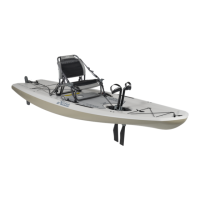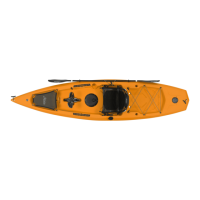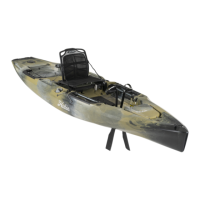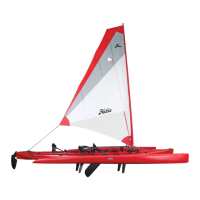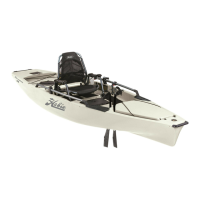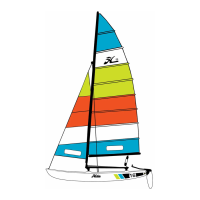PEDALING
First adjust the pedals as shown on page 4. Adjustments can
be made for a variety of leg lengths. Adjust the pedal
positions equally. Sit with
one pedal all the way
forward so your knee stays
slightly bent when your leg
is fully extended. Then you
simply pedal back and
forth to propel the boat
forward. For pedaling in
shallow water, partial
strokes with one pedal
forward and one aft allow
for shallow water sails
retraction. When there is
adequate water for
clearance of the fins, full
strokes can be used. For additional speed you can paddle as
well as pedal.
Before beaching or launching, push one pedal completely
forward to retract the Mirage Drive fins up against the hull and
kick up the rudder by flipping lever on right side of boat to the
forward (rudder up) position. To take off from the beach, push
out to deeper water or paddle out before putting the rudder
down and pedaling the Mirage Drive.
To avoid damage to the Mirage Drive, if launching from a
rocky or wavy shore, you may prefer to paddle away from the
beach and into deeper water before installing the Mirage
Drive. (Be sure to tether the drive to your kayak whenever its
not installed). You may also prefer to remove the drive before
beaching.
You can use the Mirage Tandem with one or both pedal
systems installed. When pedaling or paddling alone, sit in
the rear position. This gives access to the rudder lock-down
and steering controls. It is
preferable to remove the
forward Mirage Drive and
install the cassette plug
when pedaling alone.
PADDLING
You can choose to paddle,
pedal or combine the two.
These guidelines will help
you to get started.
To start, sit in your kayak.
Your backside should be all the way back in the seat and your
knees comfortably bent. To find the proper footwell,
straighten your legs all the way out and then bring them back
one well. If your legs are too outstretched, you may
experience strain on your lower back. If your knees are bent
too much, you may end up knocking your kneecaps while
paddling.
For proper hand placement on your paddle, start with your
hands about a shoulders width apart and centered. If you
place the center of the paddle on top of your head, your
elbows should form slightly less than a 90 degree angle.
There should be an equal amount of paddle shaft beyond
each of your hands.
Some paddles may have the blades offset, or feathered, at
some degree from parallel. A feathered paddle presents less
surface area for the wind to catch as that blade moves
forward through the air. Some paddles have a flattened spot
along the paddle shaft that will help keep your control hand
in a fixed position. However, a special technique must be
used to get each blade in the water. If the paddle is right-hand
controlled (when the right blade is held vertical, the left blade
scoop is pointed mostly up), the right hand will stay tight and
the left hand loose. To learn the process, hold the paddle tight
in your right hand and loose in your left. Using the right hand,
rotate the paddle blade back and forth; it should spin in your
left hand. Now take a stroke on your right, then cock your
right wrist back (left hand staying loose and somewhat open)
and take a stroke on your left. If using a left-hand control
paddle, reverse the process, the left hand stays tight and the
right hand stays loose.
The basic paddle stroke will give you forward power. Place a
paddle blade in the water near your toes. Pull the paddle
blade back alongside the boat to approximately your hip area
while your opposite hand and paddle blade move forward.
Then lift the first paddle blade out of the water while lowering
the second blade into the water and take a stroke with the
other side.
If you pull the paddle out and away from the hull in an arc, it
will force the bow of the boat to swing away from the paddle
blade. This is called a sweep stroke and is used to turn the
boat.
MORE PADDLING TIPS
Hobie kayaks are very easy to use and very forgiving. By
beginning in calm water, you can quickly get the feel of the
boat and paddle techniques. Practice getting in and out of the
boat by yourself.
Relax your hands when
paddling; a tight grip is not
necessary!
Sit with good posture while
keeping your torso vertical.
Choose a footrest position
that will allow your knees
to be slightly bent.
For greater efficiency use
not only your arms, but
your torso and shoulders
as well. Start out easy until you get the feel of the paddle and
the steering strokes. Most experienced paddlers use an
offset (feathered) paddle, but beginners may prefer to keep
the paddle blades square.
6
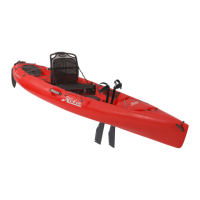
